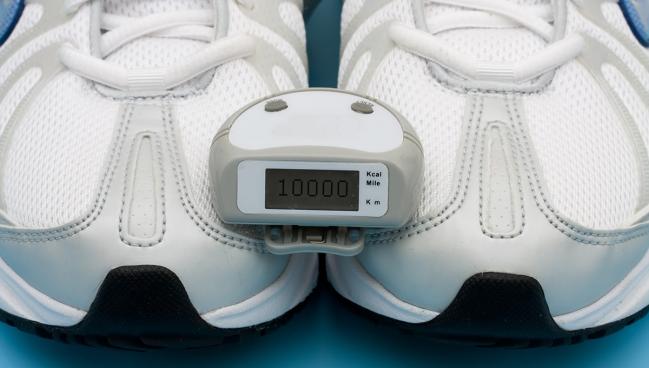Just a Few Thousand Steps Can Help Reduce CV Harms of Sitting
Around 10,000 steps appears best, but even lesser amounts can have a positive impact for people with a sedentary lifestyle.

It’s possible to reduce the mortality and CV risks associated with sitting for long stretches of time simply by getting in daily steps, an analysis of UK Biobank data suggests. The greatest risk reductions were seen at around 10,000 steps each day, but even lesser amounts were helpful.
This knowledge is valuable when counseling patients, the researchers point out in their paper published online Tuesday in the British Journal of Sports Medicine.
“We know that promotion of physical activity can improve cardiovascular health and lower the risk of mortality. However, for the general public, sometimes it’s really difficult to comprehend what is [considered] moderate and vigorous activity,” said lead author Matthew N. Ahmadi, PhD (University of Sydney, Australia). “But step count is very intuitive and easy and concrete to see and understand, and because of the proliferation of wearables like Fitbits and Garmins, it’s becoming much easier now for people to keep track of how much activity they’re doing through step count.”
Speaking with TCTMD, he said that for this study, they wanted to look not only at physical activity but also at its flip side: sedentary time. “In today’s world, sometimes it’s unavoidable to be highly sedentary, especially if you have an office job,” said Ahmadi.
Step count is very intuitive and easy and concrete to see and understand. Matthew N. Ahmadi
Niels Stens, MSc (Radboud University Medical Center, Nijmegen, the Netherlands), lead author of a 2023 study that similarly showed just a few thousand steps could make a dent in mortality and CV risk, told TCTMD this latest report supports growing evidence that it doesn’t take much to offset the known harms of a sedentary lifestyle. Studies have shown, for instance, that regular, light walking breaks and short bouts of physical activity are enough to make a difference.
“I think the main takeaway from this paper is that it doesn’t seem to matter whether you’re sitting not as much or sitting a lot: the effects of physical activity seem quite similar,” said Stens. “That’s very good, of course. Maybe future guidelines should include, for example, a step-count threshold that may be used in clinics for physicians to prescribe for patients.”
Current US and European clinical guidelines recommend 150 to 300 minutes of moderate-intensity physical activity or 75 to 150 minutes of vigorous physical activity each week for health benefits.
Around 10,000 the Best
Ahmadi and colleagues analyzed data on 72,174 UK Biobank participants (mean age 61.1 years; 57.9% female). Over a 7-year period ending in October 2021, there were 1,633 deaths and 6,190 CVD events. Physical activity was tracked via wrist-worn accelerometers.
With 2,200 daily steps as the reference group—a threshold chosen because it was the 5th percentile—the lowest point in the all-cause mortality curve fell between 9,000 and 10,500 steps. This amount of activity was associated with a lower likelihood of death no matter whether individuals were sedentary for less than 10.5 hours (HR 0.69; 95% CI 0.52-0.92) or for longer periods (HR 0.61; 95% CI 0.51-0.73) over the course of the day.
The lowest risk for incident CVD, meanwhile, was seen at around 9,700 steps per day. Again, there were reductions in risk for people sedentary less than 10.5 hours per day (HR 0.71; 95% CI 0.61-0.83) and, to a lesser but still significant degree, for those who sat for longer (HR 0.79; 95% CI 0.72-0.86).
But even with just 4,000 to 4,500 steps—half of the optimal amount—there were lower risks of all-cause mortality for those with shorter sedentary times (HR 0.84; 95% CI 0.74-0.97) and longer sedentary times (HR 0.80; 95% CI 0.74-0.87). The same patterns were seen for incident CVD (HR 0.86; 95% CI 0.80-0.92 with sitting < 10.5 h and HR 0.90; 95% CI 0.86-0.94 with sitting ≥ 10.5 h).
“These findings provide tangible targets that can be easily implemented in future steps-based and sedentary time-based interventions, and can inform the first generation of device-based guidelines,” the investigators write.
The main takeaway from this paper is that it doesn’t seem to matter whether you’re sitting not as much or sitting a lot: the effects of physical activity seem quite similar. Niels Stens
Ahmadi pointed out that it was somewhat surprising to see the 10,000-step threshold. That number, though a popular target for walking goals today, was conceived decades ago as a marketing ploy to promote the 1964 Summer Olympics in Tokyo.
However, the decreased risks seen around 4,500 daily steps “is a really nice finding as well,” he said. So, while reaching the goal of 10,000 is best, “any amount of steps gained, or movement and activity, can improve someone’s health and lower their risk of disease and death.”
Ahmadi said that future research should look into whether there’s an advantage to getting more steps in at once, such as through a longer walk, versus scattered throughout the day. There’s also the question of whether step counts equally influence the various forms of cardiovascular disease.
Stens pointed out that, in their own research, intensity did appear to be a factor. Also, there may be patient characteristics that either dilute or augment the impact of step count. Still, “it’s reassuring that almost everyone seems to benefit from physical activity,” and that small gains do matter, he noted. “These levels are actually quite achievable for patients [and] are even feasible for those that have chronic diseases or other problems that may interfere with walking.”
Caitlin E. Cox is News Editor of TCTMD and Associate Director, Editorial Content at the Cardiovascular Research Foundation. She produces the…
Read Full BioSources
Ahmadi MN, Rezende LFM, Ferrari G, et al. Do the associations of daily steps with mortality and incident cardiovascular disease differ by sedentary time levels? A device-based cohort study. Br J Sports Med. 2024;Epub ahead of print.
Disclosures
- The study is funded by an Australian National Health and Medical Research Council investigator grant and a National Heart Foundation fellowship.
- Ahmadi and Stens report no relevant conflicts of interest.





Comments